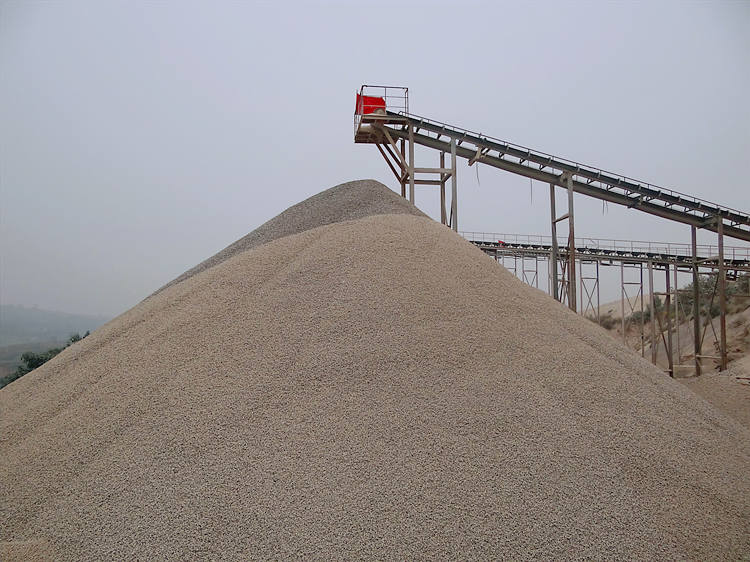Product Knowledge
How to Produce High-quality Machine-made Sand?
author:dahua2 time:2025-03-13
As a substitute for natural sand, machine-made sand is easy to obtain and the particle size distribution is easy to control. At the same time, compared with the mining of natural sand, the acquisition of machine-made sand has relatively less damage to the environment. The range of machine-made sand raw materials is wide, which can meet the demand for sand and gravel aggregates in infrastructure construction projects. Therefore, with the introduction of natural sand mining policies in recent years, machine-made sand has gradually replaced natural sand as the preferred material in the construction field.
Machine-made sand is sand processed by machine crushing. Therefore, the raw materials and production equipment of machine-made sand are indispensable. Not only sand-making equipment is needed, but also related supply, transportation, screening, cleaning and other equipment are needed to assist production, so as to cooperate with high efficiency, high energy and high yield. The quality control of machine-made sand is one of the key links in its application and promotion. Only high-quality machine-made sand can prepare high-performance machine-made sand concrete. The following is a detailed introduction on how to produce high-quality machine-made sand.
Generally speaking, the production of high-quality machine-made sand needs to start from the following aspects: material selection, equipment, process, quality control, etc.
Material selection
The chemical composition and mineral composition of the parent rock determine whether the machine-made sand contains harmful substances and whether it has alkali-aggregate reactivity. The parent rock for processing machine-made sand must not have potential alkali-aggregate reactivity, and clean, hard, and free of weak particles or weathered rocks should be selected.
The strength of the parent rock is directly related to the crushing value of the mechanical properties. Machine-made sand has specific requirements for strength, so it is required to select rocks with higher hardness as the raw materials for machine-made sand. The strength of the machine-made sandstone parent rock should be: at least 100MPa for igneous rocks, not less than 80MPa for metamorphic rocks, and not less than 60MPa for sedimentary rocks. Granite, basalt, river pebbles, etc. are generally recommended, with compressive strength ≥150MPa, high silica content, high hardness, and good sand shape, which are the basis for producing high-quality sand. For machine-made sand prepared with C60 and above concrete, the ratio of the compressive strength of the parent rock to the strength grade of the concrete should not be less than 1.5.
It is very important to control the mud content in the raw materials. When mining, we should prevent soil, weathered rocks, tree roots, grass and other debris from mixing into the rocks; try to reduce the proportion of harmful raw materials such as mud and phyllite. For example, phyllite quickly turns into mud when it meets water, which increases the difficulty of the later mineral processing process and affects the quality of sand; prevent mud from mixing into the lump ore during loading and unloading; when a large amount of mud is mixed into the lump ore, the ore should be picked out manually; the block material should be further screened out of soil by a vibrating feeder.
Before selecting materials, the rock substrate must be sampled and tested. The rock compressive strength, lithology, sulfide, sulfate content, etc. must meet the requirements to ensure the quality of the substrate.
Generally speaking, the quality control of machine-made sand is controlled by selecting raw materials and producing sand and gravel aggregates that meet the regulations. Choose the parent rock with fewer impurities, such as soil and light materials. There are many raw materials that can be used for artificial sand, generally including granite, basalt, river pebbles, cobblestones, limestone, calcite, andesite, rhyolite, diorite, diabase, sandstone, tailings, slag, quartzite, etc. Artificial sand made from different rocks has different strengths and particle sizes, and the corresponding uses will also be different. The following is a brief introduction to the uses of several ore sand making:
1) Sandstone: It has a high quartz content and is widely used in sand and gravel production lines. The problem of stone powder must be solved during the production process.
2) Quartz sandstone: Quartz sandstone is a high-quality sand making raw material, and its strength and particle shape can reach or even exceed that of natural sand.
3) River pebbles: River pebbles are also high-quality sand making raw materials. Their strength, particle shape, and color are the best choices to replace natural sand.
4) Limestone: It can be used as a sand and gravel raw material for sand and gravel production lines at the same time, and the stone powder can also be reused.
5) Basalt: Sand made of basalt is added to concrete to make the concrete lighter but still very strong. It also has the characteristics of sound insulation and heat insulation. It is a suitable aggregate for lightweight concrete in high-rise buildings.
6) Granite: Granite with high quartz content and low sulfide content is a high-quality sand-making raw material, but the powder problem must be solved.
Production equipment
Machine-made sand is processed by machines, so it is very important to produce machine-made sand production equipment. With the large-scale development of the sand and gravel industry, machine-made sand production equipment has gradually completed the transformation from low-yield and low-quality to high-yield, high-quality, intelligent and environmentally friendly.
Common crushing equipment combinations for producing machine-made sand are:
Jaw crusher + impact crusher;
Jaw crusher + cone crusher;
Jaw crusher + roller crusher;
Jaw crusher + impact crusher + impact sand making and shaping machine;
Jaw crusher + cone crusher + impact sand making and shaping machine or sand making system.
Artificial sand production process
The production process mainly reflects the process and quality control factors that affect the quality of artificial sand.
The basic production process of artificial sand can generally be divided into mine rock → coarse crushing → medium crushing (some with screening) → fine crushing → screening → dust removal → finished artificial sand.
The sand and gravel aggregate beneficiation process can be selected according to the production situation. The full dry method, full wet method, and dry-wet combination method.
Considering the quality of sand and gravel aggregate products, it is recommended to adopt a full wet sand making process. Including feeding, crushing, sand making, screening, etc., all use flowing water for washing. Through water washing, the mud, phyllite, and stone powder in the raw materials can be removed to the greatest extent, the distribution of artificial sand particles can be optimized, and the quality of artificial sand products can be improved.
The artificial sand produced by the dry production process has a low moisture content and high output, but it is difficult to control the fineness and stone powder content, and the finished material is prone to segregation. The artificial sand produced by the wet production process has an easy-to-control content of stone powder, but it pollutes the environment, has a low output, and is prone to unqualified grading and excessive fineness modulus.
Compared with the dry sand making process, the fully wet sand making process has less impact on the environment, less dust during the production process, and the filtered mud cake can be reused as a raw material for brick making.
Previous Article:No Information
Next Article: The Process and Economic Considerations of Quartz Sand Crushing Plant


.jpg)





